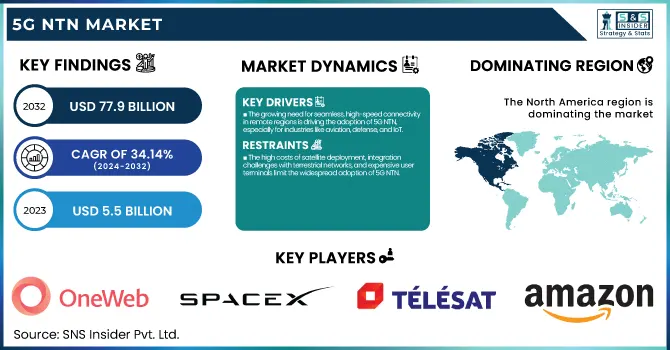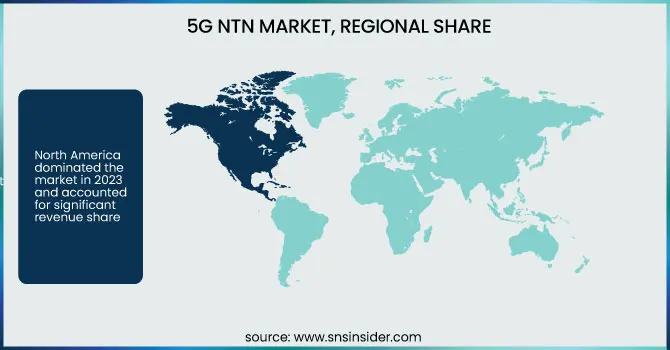5G NTN Market Report Scope & Overview:
The 5G NTN Market was valued at USD 5.5 Billion in 2023 and is expected to reach USD 77.9 Billion by 2032, growing at a CAGR of 34.14% from 2024-2032.

To Get more information on 5G NTN Market - Request Free Sample Report
The 5G NTN Market is witnessing significant advancements, with deployment progress varying by region as nations invest in satellite and HAPS-based 5G connectivity. Industries such as aerospace, maritime, defense, and IoT are rapidly adopting 5G NTN solutions to enhance global coverage and seamless communication. Key market players are making substantial investments in infrastructure, driving innovation in satellite constellations and edge computing for NTN. Additionally, data traffic via 5G NTN is surging, particularly in applications like broadband, IoT, and emergency communications. The report also explores regulatory developments, technological advancements in NTN protocols, and integration with terrestrial 5G networks to enhance connectivity.
5G NTN Market Dynamics
Drivers
-
The growing need for seamless, high-speed connectivity in remote regions is driving the adoption of 5G NTN, especially for industries like aviation, defense, and IoT.
Growing demand for ubiquitous, high-speed connectivity across remote, rural & maritime areas is driving the adoption of 5G NTN solutions. In such regions, traditional terrestrial networks have little or no coverage, where satellite-based 5G comes as a promising alternative. Several industries, including aviation and defense, utilize 5G NTN, and governments also want to boost satellite communication in support of national security and disaster management. Moreover, the widespread deployment of the Internet of Things, smart agriculture, and self-driving cars also contributes to demand by necessitating low-latency, high-bandwidth networks. The broader introduction of Low Earth Orbit satellites is further pushing the global 5G NTN take-up.
Restraints
-
The high costs of satellite deployment, integration challenges with terrestrial networks, and expensive user terminals limit the widespread adoption of 5G NTN.
While offering significant potential, the implementation of 5G NTN is limited by the large capital expenditures linked to launching satellites, network infrastructure, and upkeep. Establishing non-terrestrial networks such as LEO, MEO, and GEO satellites needs substantial capital, making them hard to access for smaller telecom operators. Moreover, the synergy between 5G NTN and terrestrial networks also comes with technical challenges such as spectrum sharing or signal latency issues. User terminals and ground stations are also expensive, perpetuating the small-scale problem. Indeed, without economical solutions and governmental subsidies, commercial 5G NTN will be a strong issue for low GDP countries.
Opportunity
-
Innovations in satellite technology, AI-driven network optimization, and hybrid NTN-terrestrial 5G networks are expanding growth opportunities for 5G NTN.
The advances in satellite communication, especially the integration of software-defined payloads, beamforming, and AI-based network optimization, are increasing the efficiency and scalability of 5G NTN. Increasing collaborations between satellite operators and telecom providers are facilitating hybrid networks which effortlessly combine NTN and terrestrial 5G to provide expanded coverage. In addition, compact and low-cost user terminals are facilitating the access of satellite-based 5G to consumers and corporate users. Applications in smart cities, disaster response, and autonomous transportation offer new growth opportunities. Additionally, the sector is emphasized with favorable policies and spectrum allotment by governments and space agencies, spurring investments in NTN-based 5G networks.
Challenges
-
Regulatory complexities, spectrum allocation disputes, and space debris concerns pose significant challenges to the large-scale deployment of 5G NTN networks.
Some countries are facing significant regulatory challenges originating from issues, especially spectrum allocation and cross-border signal interference, in the 5G NTN market. Different nations also have different regulatory frameworks, which makes the creation of global common standards practically difficult. Financial Site Coordination among satellite operators, telecom providers and regulatory bodies is vital to avoid spectrum congestion and ensure the use of frequencies is carried out effectively. The growing amount of space junk and traffic management problems raises questions about the long-term sustainability of LEO satellite deployments. Resolving such regulatory blockages will need international coordination, checking the right local policies between commercial benefits and national security, and the environmental factors. Operationalization of 5G NTN networks at scale could therefore be delayed if regulatory frameworks are not streamlined.
5G NTN Market Segmentation Analysis
By Component
In 2023, the hardware segment dominated the market and accounted for 47% of revenue share. This part includes stuff like satellites, antennas, and land arrangements that are expected for building and working a 5G NTN base. A significant market share is being driven by the hardware, as the role of the hardware becomes pivotal to ensure reliable connectivity and high performance irrespective of the environment.
The services segment is expected to register the fastest CAGR during the forecast period. These services include network management, maintenance and data analysis, which is growing in importance with the rollout of 5G non-terrestrial network deployments. Even better, service providers are creating complex solutions that deliver network performance and handle a range of apps, increasing their market appeal.
BY Platform
In 2023, UAS platforms dominated the market and held the largest share of the market. UAS platforms, which certainly include drones and other Aerial Vehicles, provide the most versatile high-altitude Connectivity solutions possible, making them a perfect candidate for 5G Network coverage expansion.
The segment of LEO satellites is projected to expand rapidly between 2024 and 2032. The LEO satellites have many potential benefits, including lower latency and better global coverage, which are both key for improving 5G connectivity. The capabilities of satellites are expanding, as is the market, with more constellations being developed and launched. With LEO satellites representing an emerging front in the quest for global connectivity, investment in satellite infrastructure is increasing.
By Location
In 2023, the urban segment dominated the market and held the 49.6 % market revenue share. Urbanized areas urgently require high-speed, high-bandwidth, reliable internet to support wide-ranging applications including smart cities and massive IoT networks. Owing to the very dense infrastructure and dense users, urban areas are a major target segment for NTN deployments and there are significant investments on technologies in network capacity and performance.
The Rural segment is expected to register the fastest CAGR during the forecast period. More cost-effective 5G NTN solutions are being carried out in remote regions to bridge the digital divide and fill the gap of certain leading-edge services in typical locations with limited infrastructure. However, with the improvement of satellite modalities and affordable satellite architectures, realizing NTN systems at these remote locations is becoming highly anticipated to implement.
By Application
In 2023, Enhanced Mobile Broadband segment dominated the market and accounted for 52.8% of revenue share. Enhance Mobile Broadband segment will account for the majority share of the 5G non-terrestrial network market owing to rising demand of high translating composite indices connecting and augmented capacity supplying. Making our smartphone experience better with improved data rates in urban and remote areas, EMBB applications are fundamental.
Massive Machine-Type Communications segment is anticipated to expand at the fastest rate during the forecast years. MMTC is used to facilitate simultaneous communication among a large number of devices, which is important in smart agriculture, industrial automation, smart cities, etc. The proliferation of 5G NTN technology has recently made the impressive connectivity requirements of 5G MMTC easier to satisfy.
By End-Use
In 2023, the aerospace & defense segment dominated the market and accounted for 41.7% of revenue share. The segment growth is due to the requirement of high-reliability, secure, and high-speed communications in the sector. NTN is essential for military and aerospace applications that require coverage in remote and difficult-to-reach locations, and provides value in this segment. NTN enabler: NTN technology brought in to support operationally-relevant functions, including surveillance, navigation, and tactical communications.
The maritime segment is expected to register the fastest CAGR during the forecast period. Rise in demand for uninterrupted and high-speed connectivity at sea is attracting the segment. As shipping and other maritime operations expand worldwide, the demand for NTN solutions to enable high-speed communication and data transfer capacity for similar civil and military mandates in remote oceanic regions exists.
Regional Analysis
The North America dominated the market in 2023 and accounted for 33.2% of revenue share. To improve the connectivity mainly in the remote/underprivileged regions, the U.S. and Canada are taking the lead in NTN technology development. NTN solutions are witnessing a lot of investment driven by increasing need for high-speed internet and increasing trend of IoT devices. Also, various measures taken by North America towards 5G integration with satellite and high-altitude platforms are garnering attention related to the demand for holistic coverage along with reliable reliability.
The Asia-Pacific is expected to register the fastest CAGR during the forecast period. The Major economies in the world, including China, Japan, and South Korea, are leading NTN technologies to improve connectivity in different space scenarios. The demand for NTN solutions in the region is driven by the focus of the region towards smart-city development, increasing applications of IoT, as well as the promotion of advanced technologies, such as autonomous vehicles.

Get Customized Report as per Your Business Requirement - Enquiry Now
5G NTN Market Key Players
The major key players along with their products are
-
SpaceX – Starlink
-
OneWeb – OneWeb LEO Satellite Network
-
Telesat – Lightspeed Constellation
-
Amazon (Project Kuiper) – Kuiper Satellite System
-
AST SpaceMobile – BlueWalker 3
-
SES S.A. – O3b mPOWER
-
Eutelsat – EUTELSAT KONNECT VHTS
-
Inmarsat (Viasat Inc.) – ORCHESTRA Network
-
Thales Group – Thales Alenia Space SATCOM Solutions
-
Lockheed Martin – Pony Express 1
-
Hughes Network Systems – Jupiter 3 Satellite
-
Nokia – Nokia AVA for NTN
-
Ericsson – Ericsson 5G Core for NTN
-
Huawei – 5G NTN Integrated Solutions
-
Intelsat – FlexMove Connectivity
Recent Developments
1. November 2024: AST SpaceMobile's stock surged after signing a long-term agreement with Vodafone, extending until 2034, to provide space-based cellular broadband connectivity in Europe and Africa.
2. November 2024: Nokia secured a multi-billion-dollar deal with India's Bharti Airtel to supply 4G and 5G equipment, aiming to expand Bharti Airtel's network across India.
3. October 2024: Australia's TPG Telecom completed the removal of Huawei technology from its 5G network, replacing it with Nokia's equipment, enhancing network security and performance.
|
Report Attributes |
Details |
|
Market Size in 2023 |
USD 5.5 Billion |
|
Market Size by 2032 |
USD 77.9 Billion |
|
CAGR |
CAGR of 34.14% From 2024 to 2032 |
|
Base Year |
2023 |
|
Forecast Period |
2024-2032 |
|
Historical Data |
2020-2022 |
|
Report Scope & Coverage |
Market Size, Segments Analysis, Competitive Landscape, Regional Analysis, DROC & SWOT Analysis, Forecast Outlook |
|
Key Segments |
• By Component (Hardware, Software, Services.) |
|
Regional Analysis/Coverage |
North America (US, Canada, Mexico), Europe (Eastern Europe [Poland, Romania, Hungary, Turkey, Rest of Eastern Europe] Western Europe] Germany, France, UK, Italy, Spain, Netherlands, Switzerland, Austria, Rest of Western Europe]), Asia Pacific (China, India, Japan, South Korea, Vietnam, Singapore, Australia, Rest of Asia Pacific), Middle East & Africa (Middle East [UAE, Egypt, Saudi Arabia, Qatar, Rest of Middle East], Africa [Nigeria, South Africa, Rest of Africa], Latin America (Brazil, Argentina, Colombia, Rest of Latin America) |
|
Company Profiles |
SpaceX, OneWeb, Telesat, Amazon (Project Kuiper), AST SpaceMobile, SES S.A., Eutelsat, Inmarsat (Viasat Inc.), Thales Group, Lockheed Martin, Hughes Network Systems, Nokia, Ericsson, Huawei, Intelsat. |

